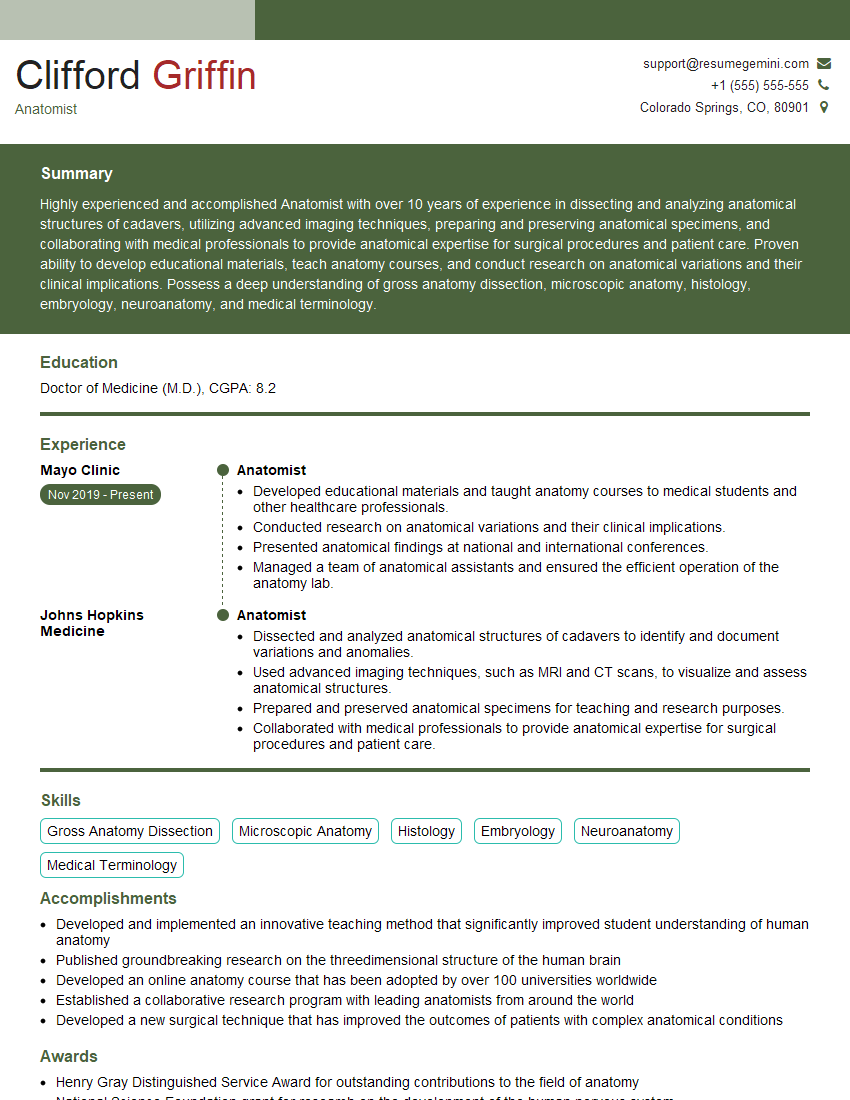Are you a seasoned Anatomist seeking a new career path? Discover our professionally built Anatomist Resume Template. This time-saving tool provides a solid foundation for your job search. Simply click “Edit Resume” to customize it with your unique experiences and achievements. Customize fonts and colors to match your personal style and increase your chances of landing your dream job. Explore more Resume Templates for additional options.

Clifford Griffin
Anatomist
Summary
Highly experienced and accomplished Anatomist with over 10 years of experience in dissecting and analyzing anatomical structures of cadavers, utilizing advanced imaging techniques, preparing and preserving anatomical specimens, and collaborating with medical professionals to provide anatomical expertise for surgical procedures and patient care. Proven ability to develop educational materials, teach anatomy courses, and conduct research on anatomical variations and their clinical implications. Possess a deep understanding of gross anatomy dissection, microscopic anatomy, histology, embryology, neuroanatomy, and medical terminology.
Education
Doctor of Medicine (M.D.)
October 2015
Skills
- Gross Anatomy Dissection
- Microscopic Anatomy
- Histology
- Embryology
- Neuroanatomy
- Medical Terminology
Work Experience
Anatomist
- Developed educational materials and taught anatomy courses to medical students and other healthcare professionals.
- Conducted research on anatomical variations and their clinical implications.
- Presented anatomical findings at national and international conferences.
- Managed a team of anatomical assistants and ensured the efficient operation of the anatomy lab.
Anatomist
- Dissected and analyzed anatomical structures of cadavers to identify and document variations and anomalies.
- Used advanced imaging techniques, such as MRI and CT scans, to visualize and assess anatomical structures.
- Prepared and preserved anatomical specimens for teaching and research purposes.
- Collaborated with medical professionals to provide anatomical expertise for surgical procedures and patient care.
Accomplishments
- Developed and implemented an innovative teaching method that significantly improved student understanding of human anatomy
- Published groundbreaking research on the threedimensional structure of the human brain
- Developed an online anatomy course that has been adopted by over 100 universities worldwide
- Established a collaborative research program with leading anatomists from around the world
- Developed a new surgical technique that has improved the outcomes of patients with complex anatomical conditions
Awards
- Henry Gray Distinguished Service Award for outstanding contributions to the field of anatomy
- National Science Foundation grant for research on the development of the human nervous system
- American Association of Anatomists Presidents Award for Excellence in Teaching
- Recipient of the NIH Directors Pioneer Award for research on the molecular basis of human development
Certificates
- Certified Anatomical Pathologist (CAP)
- Board Certified Clinical Anatomist (BCCA)
- American Board of Anatomists (ABA)
- National Board for Certification in Occupational Safety and Health
Career Expert Tips:
- Select the ideal resume template to showcase your professional experience effectively.
- Master the art of resume writing to highlight your unique qualifications and achievements.
- Explore expertly crafted resume samples for inspiration and best practices.
- Build your best resume for free this new year with ResumeGemini. Enjoy exclusive discounts on ATS optimized resume templates.
How To Write Resume For Anatomist
Highlight your skills and experience:
Emphasize your expertise in gross anatomy dissection, microscopic anatomy, histology, embryology, neuroanatomy, and medical terminology.Quantify your accomplishments:
Use specific numbers and metrics to demonstrate the impact of your work, such as the number of cadavers dissected, specimens prepared, or students taught.Showcase your research and publications:
List any research projects you have been involved in or publications you have authored or co-authored.Get feedback on your resume:
Ask a trusted colleague, mentor, or career counselor to review your resume and provide feedback to enhance its effectiveness.
Essential Experience Highlights for a Strong Anatomist Resume
- Dissected and analyzed anatomical structures of cadavers to identify and document variations and anomalies.
- Used advanced imaging techniques, such as MRI and CT scans, to visualize and assess anatomical structures.
- Prepared and preserved anatomical specimens for teaching and research purposes.
- Collaborated with medical professionals to provide anatomical expertise for surgical procedures and patient care.
- Developed educational materials and taught anatomy courses to medical students and other healthcare professionals.
- Conducted research on anatomical variations and their clinical implications.
- Managed a team of anatomical assistants and ensured the efficient operation of the anatomy lab.
Frequently Asked Questions (FAQ’s) For Anatomist
What are the primary responsibilities of an Anatomist?
The primary responsibilities of an Anatomist include dissecting and analyzing anatomical structures, using advanced imaging techniques, preparing and preserving anatomical specimens, collaborating with medical professionals, developing educational materials, conducting research, and managing a team of anatomical assistants.
What are the educational requirements to become an Anatomist?
To become an Anatomist, a Doctor of Medicine (M.D.) degree is typically required. Additional training in anatomy, such as a residency or fellowship, may also be beneficial.
What are the key skills and qualities of a successful Anatomist?
Successful Anatomists possess a deep understanding of human anatomy, strong dissection and visualization skills, expertise in advanced imaging techniques, excellent communication and teaching abilities, and a commitment to research and professional development.
What are the career prospects for Anatomists?
Anatomists can pursue careers in academia, research institutions, hospitals, and medical schools. They may also work in forensic science, medical illustration, or other related fields.
What is the job outlook for Anatomists?
The job outlook for Anatomists is expected to be good, with a projected growth rate of 7% from 2020 to 2030.
What are the earning potential and salary expectations for Anatomists?
The earning potential for Anatomists varies depending on experience, location, and employer. According to the U.S. Bureau of Labor Statistics, the median annual salary for Anatomists was $104,040 in May 2020.
What are the challenges and rewards of working as an Anatomist?
Challenges of working as an Anatomist can include the physical demands of dissection, exposure to potentially hazardous materials, and the need for continuous learning and professional development. Rewards include contributing to medical knowledge, educating future healthcare professionals, and making a difference in the lives of patients.